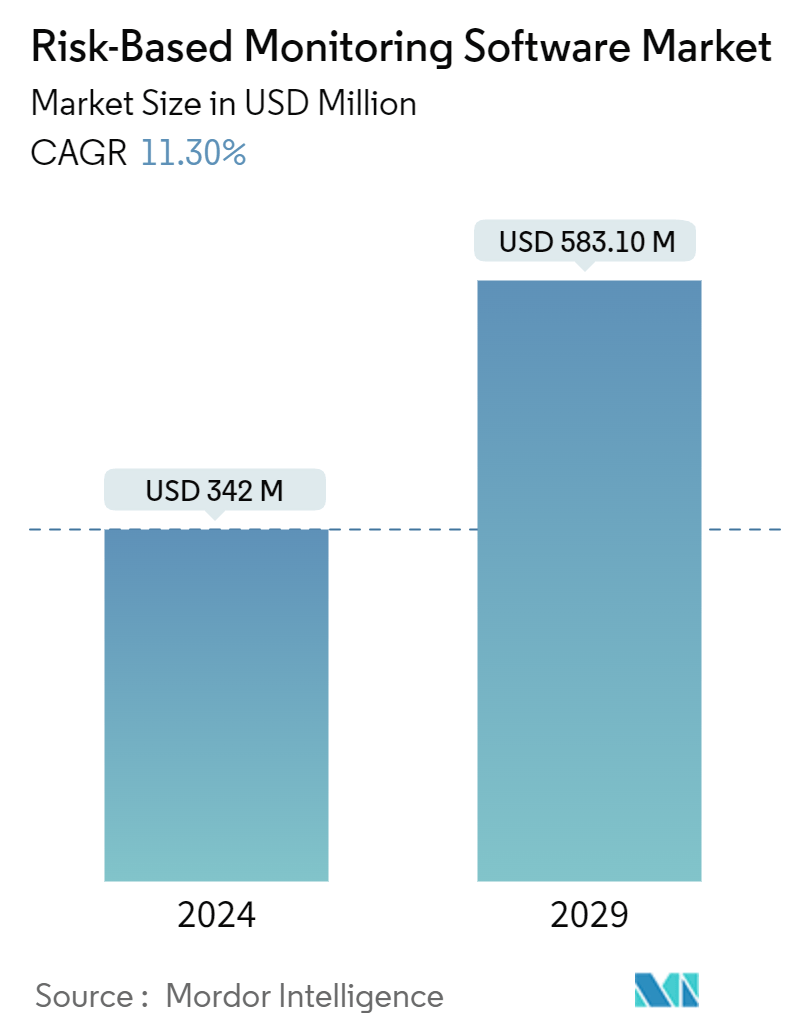Market Size of Risk-Based Monitoring Software Industry

| Study Period | 2019 - 2029 |
| Market Size (2024) | USD 342 Million |
| Market Size (2029) | USD 583.10 Million |
| CAGR (2024 - 2029) | 11.30 % |
| Fastest Growing Market | Asia Pacific |
| Largest Market | North America |
| Market Concentration | Medium |
Major Players
*Disclaimer: Major Players sorted in no particular order |
Risk-Based Monitoring Software Market Analysis
The Risk-Based Monitoring Software Market size is estimated at USD 342 million in 2024, and is expected to reach USD 583.10 million by 2029, growing at a CAGR of 11.30% during the forecast period (2024-2029).
Increasing demand for high-efficiency, risk-based monitoring software, coupled with growing government funding and support for clinical trials and technological advancements, is expected to expand the market.
As regulatory bodies promote risk-based monitoring approaches, there is a growing demand for RBM software that can streamline data collection, analysis, and risk assessment processes. These software solutions leverage technologies like AI and machine learning to identify and prioritize high-risk areas, thereby optimizing monitoring efforts and enhancing overall trial efficiency. For example, in April 2023, the United States Food and Drug Administration (FDA) issued guidance on using risk-based approaches to monitor the progress of clinical research involving human drug and biological products, medical devices, and combination products. Clinical investigation monitoring is an important quality control tool for ensuring that research activities are carried out as intended. This guidance provides recommendations on how to plan a monitoring approach, develop the content of a monitoring plan, and address and communicate monitoring results. Hence, the surge in demand for advanced risk-based monitoring (RBM) software aligns with regulatory guidance emphasizing risk-based approaches. This, strengthened by increased government funding and the growing adoption of efficient clinical trial management practices, will drive market expansion growth during the forecast period.
Also, the demand for clinical trials is steadily increasing worldwide, driven by advancements in medical research and the rise of personalized medicine. Technological advancements, innovative data analysis methods, and the increasing adoption of decentralized clinical trials (DCTs) are transforming the field of clinical trials.
Moreover, as clinical trials expand in complexity, the demand for efficient monitoring solutions grows significantly. These solutions are crucial for maintaining data integrity, ensuring patient safety, and meeting rigorous regulatory standards. For instance, according to the article published by Springer in March 2022, risk-based monitoring (RBM) aims to identify events or trends that influence the quality of trials, particularly in terms of participant safety and data integrity. The adoption of RBM approaches is increasing due to their efficiency, regulatory support, and enhancement of trial quality. Thus, by enhancing data quality, streamlining monitoring processes, and optimizing resource utilization the growing demand for clinical trials drives the adoption of the market.
Additionally, the demand for web-based delivery modes is primarily driven by the rising adoption of web-based risk monitoring solutions. For instance, as per the article published by the Sustainability Journal in May 2023, the risk-based monitoring software approach is a fundamental method employed in implementing management systems, utilizing requirements from management standards and effective use in improved scalability. These solutions streamline trial management processes and facilitate real-time data access by eliminating the need for local installations and enabling access through web browsers. Thus, this proactive approach reduces costs, improves trial integrity, and meets management standards, driving growth in the risk-based monitoring software market by meeting industry demands for efficiency and regulatory compliance.
Thus, the market is expected to continue to grow in the coming years due to the aforementioned factors, such as the increasing adoption of web-based risk monitoring solutions and the rising demand for clinical trials for technological advancements. However, the high cost of implementation and data privacy and security concerns create a significant obstacle to adopting artificial intelligence during the forecast period.
Risk-Based Monitoring Software Industry Segmentation
As per the scope of the report, the risk-based monitoring (RBM) software market centers on software solutions tailored to streamline clinical trial monitoring. These solutions prioritize resources based on identified risks, boost efficiency, and ensure regulatory compliance. They leverage advanced analytics and real-time data monitoring to enhance trial outcomes, reduce costs, and ease resource burdens. The risk-based monitoring software market is segmented by component, delivery mode, end-user, and geography. By component, the market is segmented into software and services. The market is segmented by delivery mode into web-based (on-demand), on-premise, and cloud-based (SAAS). The market is segmented by end users into pharma and biopharmaceutical companies, medical device companies, contract research organizations (CROs), and other end users. By geography, the market is segmented into North America, Europe, Asia-Pacific, and Rest of the World. For each segment, the market sizing and forecasts are done based on value (in USD).
| By Component | |
| Software | |
| Services |
| By Delivery Mode | |
| Web Based | |
| On-premise | |
| Cloud-based |
| By End User | |
| Pharma and Biopharmaceutical Companies | |
| Medical Device Companies | |
| Contract Research Organizations (CRO) | |
| Other End Users |
| Geography | ||||||||
| ||||||||
| ||||||||
| ||||||||
| Rest of the World |
Risk-Based Monitoring Software Market Size Summary
The risk-based monitoring (RBM) software market is poised for significant growth, driven by the increasing demand for efficient and technologically advanced solutions in clinical trial management. This market expansion is fueled by regulatory bodies' endorsement of RBM approaches, which emphasize the importance of data-driven monitoring to enhance trial efficiency and ensure compliance with regulatory standards. The integration of artificial intelligence and machine learning technologies in these software solutions allows for the identification and prioritization of high-risk areas, optimizing monitoring efforts and improving overall trial quality. The growing complexity of clinical trials, coupled with the rise of personalized medicine and decentralized trial models, further propels the demand for RBM software, as these tools are essential for maintaining data integrity and patient safety.
The market's growth is also supported by increased government funding and strategic partnerships among key industry players, which facilitate innovation and efficiency in clinical research. Web-based delivery modes are gaining traction, offering real-time data access and reducing the need for local installations, thereby enhancing scalability and cost-effectiveness. Despite challenges such as high implementation costs and data privacy concerns, the market is expected to continue its upward trajectory, with service providers playing a crucial role in offering ongoing support and expertise in risk management and regulatory compliance. The presence of major players and their focus on regulatory approvals and product launches further contribute to the market's competitive landscape, ensuring robust growth in the coming years.
Risk-Based Monitoring Software Market Size - Table of Contents
-
1. MARKET DYNAMICS
-
1.1 Market Overview
-
1.2 Market Drivers
-
1.2.1 High Efficiency of Risk-Based Monitoring Software Coupled with Growing Government Funding and Support for Clinical Trials
-
1.2.2 Advancements in Technology
-
-
1.3 Market Restraints
-
1.3.1 High Cost of Implementation
-
1.3.2 Data Privacy and Security Concerns
-
-
1.4 Porter's Five Force Analysis
-
1.4.1 Threat of New Entrants
-
1.4.2 Bargaining Power of Buyers/Consumers
-
1.4.3 Bargaining Power of Suppliers
-
1.4.4 Threat of Substitute Products
-
1.4.5 Intensity of Competitive Rivalry
-
-
-
2. MARKET SEGMENTATION (Market Size by Value - USD)
-
2.1 By Component
-
2.1.1 Software
-
2.1.2 Services
-
-
2.2 By Delivery Mode
-
2.2.1 Web Based
-
2.2.2 On-premise
-
2.2.3 Cloud-based
-
-
2.3 By End User
-
2.3.1 Pharma and Biopharmaceutical Companies
-
2.3.2 Medical Device Companies
-
2.3.3 Contract Research Organizations (CRO)
-
2.3.4 Other End Users
-
-
2.4 Geography
-
2.4.1 North America
-
2.4.1.1 United States
-
2.4.1.2 Canada
-
2.4.1.3 Mexico
-
-
2.4.2 Europe
-
2.4.2.1 Germany
-
2.4.2.2 United Kingdom
-
2.4.2.3 France
-
2.4.2.4 Italy
-
2.4.2.5 Spain
-
2.4.2.6 Rest of Europe
-
-
2.4.3 Asia-Pacific
-
2.4.3.1 China
-
2.4.3.2 Japan
-
2.4.3.3 India
-
2.4.3.4 Australia
-
2.4.3.5 South Korea
-
2.4.3.6 Rest of Asia-Pacific
-
-
2.4.4 Rest of the World
-
-
Risk-Based Monitoring Software Market Size FAQs
How big is the Risk-Based Monitoring Software Market?
The Risk-Based Monitoring Software Market size is expected to reach USD 342 million in 2024 and grow at a CAGR of 11.30% to reach USD 583.10 million by 2029.
What is the current Risk-Based Monitoring Software Market size?
In 2024, the Risk-Based Monitoring Software Market size is expected to reach USD 342 million.

